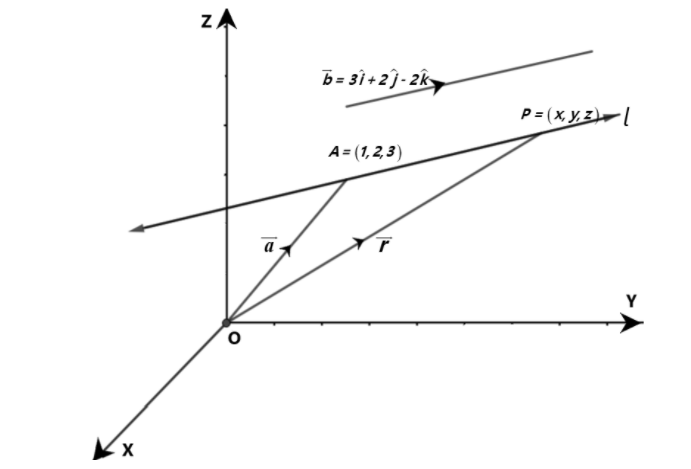Question
Question: Find the equation of the line in vector form which passes through \[\left( {1,2,3} \right)\] and par...
Find the equation of the line in vector form which passes through (1,2,3) and parallel to the vector 3i+2j−2k.
Solution
Hint : Here in this question, we have to find the vector equation of a line passing through a point with position vector a and parallel to a vector busing a equation r=a+λb, where a is the line passes through (1,2,3) so a=1i+2j+3k and b=3i+2j−2k , on substituting we get the required solution.
Complete step-by-step answer :
Let a be the position vector of the given point A with respect to the origin O of the rectangular coordinate system. Let l be the line which passes through the point A and is parallel to a given vector b. Let r be the position vector of an arbitrary point P on the line.

Here, AP is parallel to the vector b, i.e., AP=λb, where λ is some real number.
But
AP=OP−OA
λb=r−a
Hence, the vector equation of the line is given by r=a+λb-----(1)
Given, the line passes through (1,2,3), so the position vector a=1i+2j+3k and parallel to the vector 3i+2j−2k.
Now, putting value of a and b in equation (1), we have
∴r=(1i+2j+3k)+λ(3i+2j−2k)
Hence, the above equation is a vector equation of line which passes through (1,2,3) and parallel to the vector 3i+2j−2k.
So, the correct answer is “Option B”.
Note : Remember, the above solved equation is in vector form and one more form of equation i.e., cartesian form of a line passing through the point (x1,y1,z1) and parallel to the vector ai+bj+ck is given as ax−x1=by−y1=cz−z1.
The cartesian form of equation of given question is
Where, (x1,y1,z1)=(1,2,3) and ai+bj+ck=3i+2j−2k i.e., a=3, b=2, c=-2
Then by formula we can written the cartesian equation as:
3x−1=2y−2=−2z−3.
